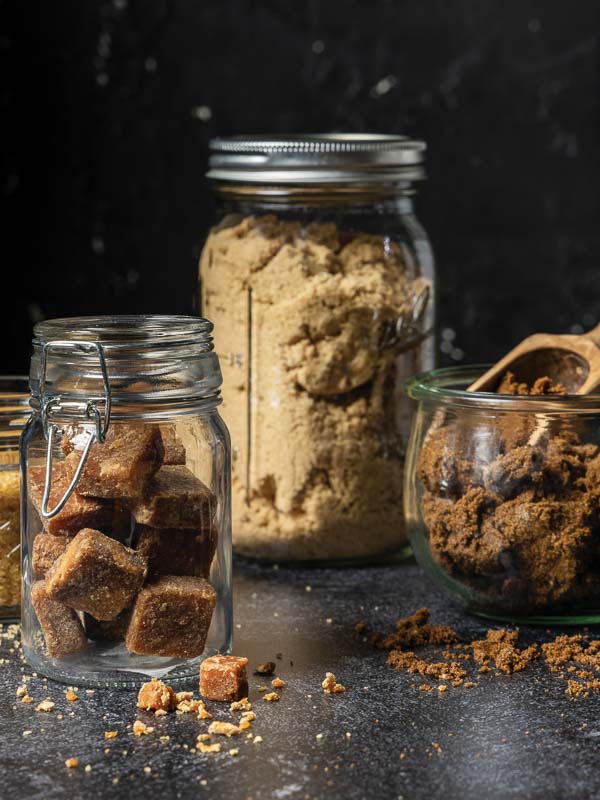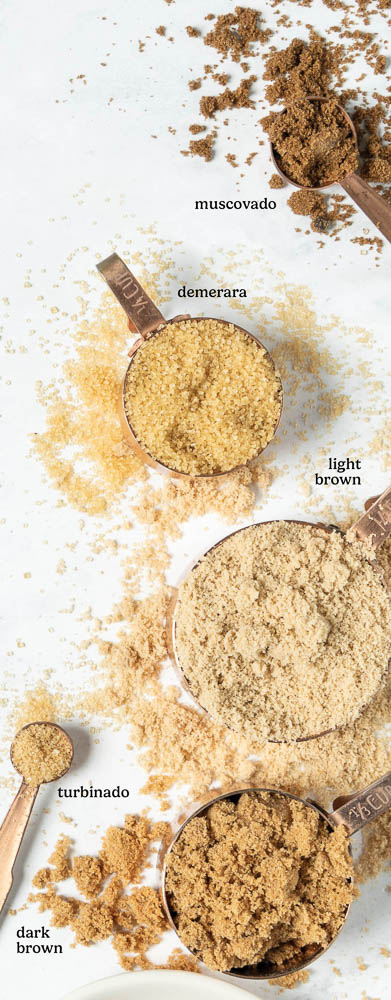

My love for brown sugar began when I was barely tall enough to see over the kitchen counter, no more than 7 years old. I would help my mom stir pecan pie filling while sneaking a finger in to taste the rich sugars. As a child growing up in Costa Rica, I enjoyed many advantages, one of which was living close enough to witness the enchantment of sugarcane being processed at a nearby plant.
One fateful field trip sealed my love for all things sugar for the rest of my life. The air was thick with the heat from the fires burning underneath massive basins filled with boiling cane juice. The entire plant smelled of molasses, that rich caramel scent that left you with the strongest desire to get your hands on some sugar. This plant was producing panela, also known as tapa de dulce in Costa Rica. Watching the workers wield massive poles with buckets attached at the ends as they transferred the thick syrups into molds filled my classmates and me with awe. I’ll never forget the joy of being handed a small block of tapa de dulce at the end of the field trip. That joy continues to this day as I bake cookies and cakes filled with sugars rich in molasses.
Brown sugar is a crucial ingredient in baking, not only for its delightful flavor but also for its significant role in enhancing your baked goods. All sugar comes from either sugarcane or sugar beet plants. The top nations that produce sugarcane are Brazil, China, India, Thailand, and the United States, though sugarcane can be grown in most tropical regions, including parts of Africa, Central and South America, and Australia. Sugar beets are hardier and can withstand frost; their most common growing regions are Canada, Europe, and Russia. Bake from Scratch Official Test Kitchen Partner C&H® Sugar sources its sugarcane from Hawaii, Australia, and parts of South America. These plants undergo many processes before they become the sugars we know and purchase at the store. After raw sugar has been removed of impurities and crystallized, it’s then passed through a centrifuge to remove excess liquid; the byproduct of this process is molasses. This is the turning point in the sugar-refining process where we get all the different forms of sugar, from white granulated to dark brown sugar and turbinado, and many other varieties. The main difference between these sugars is the amount of molasses in them.
 Light and dark brown sugars are the most well-known versions of brown sugar and the easiest to find in stores. These brown sugars are made by reintroducing molasses to granulated sugar. The difference between them is simply the amount of molasses that is mixed in. Light brown sugar, as the name implies, contains less molasses (about 3% to 4%) and is used more often in baking than its richer counterpart. When a recipe calls for “brown sugar” without specifying which kind, it’s safe to assume light brown is the version it’s referring to. Dark brown sugar contains approximately 6% to 10% molasses, giving it a richer and stronger caramel flavor. Dark brown sugar is most often used in making gingerbread and other recipes that have a longer baking or cooking time, given its increased moisture. Using these two sugars in your baking adds moisture to your baked goods because of the molasses content. Light and dark brown sugars can be used interchangeably, but keep in mind that you’ll have slight variations in the final color, moisture content, and flavor of your recipe.
Light and dark brown sugars are the most well-known versions of brown sugar and the easiest to find in stores. These brown sugars are made by reintroducing molasses to granulated sugar. The difference between them is simply the amount of molasses that is mixed in. Light brown sugar, as the name implies, contains less molasses (about 3% to 4%) and is used more often in baking than its richer counterpart. When a recipe calls for “brown sugar” without specifying which kind, it’s safe to assume light brown is the version it’s referring to. Dark brown sugar contains approximately 6% to 10% molasses, giving it a richer and stronger caramel flavor. Dark brown sugar is most often used in making gingerbread and other recipes that have a longer baking or cooking time, given its increased moisture. Using these two sugars in your baking adds moisture to your baked goods because of the molasses content. Light and dark brown sugars can be used interchangeably, but keep in mind that you’ll have slight variations in the final color, moisture content, and flavor of your recipe.
 Muscovado sugar, also known as Barbados sugar, is similar to light and dark brown sugars due to its higher molasses content and moist texture. However, this sugar does not have molasses added back in after it’s refined. Muscovado’s production journey ends at the crystallization step, when the sugarcane juices have fully evaporated and all that remains are molasses-covered granules. Muscovado sugar has a distinctly strong molasses flavor and a very moist, sandy texture. The granules tend to be stickier than those of light and dark brown sugars. It’s often used to make caramel confections and sauces as well as marinades.
Muscovado sugar, also known as Barbados sugar, is similar to light and dark brown sugars due to its higher molasses content and moist texture. However, this sugar does not have molasses added back in after it’s refined. Muscovado’s production journey ends at the crystallization step, when the sugarcane juices have fully evaporated and all that remains are molasses-covered granules. Muscovado sugar has a distinctly strong molasses flavor and a very moist, sandy texture. The granules tend to be stickier than those of light and dark brown sugars. It’s often used to make caramel confections and sauces as well as marinades.
Turbinado and demerara sugars share many similarities and are occasionally mistaken for each other. These two sugars have large, coarse granules that do not dissolve easily when baking. They’re often used for a dramatic, sparkling finish to your baked goods or when you want a lasting sweet crunch. They’re typically referred to or labeled as “raw sugar” because they’re less refined than granulated sugar and retain some molasses. The main difference between demerara and turbinado lies in the molasses content, as with all brown sugars. Demerara contains more, giving it a darker look, while turbinado is a light, sandy color.
Brown sugar tends to harden into an impenetrable block the longer it stays in your pantry, which is usually a sign that the moisture inside the sugar has evaporated. To prevent this, store it in an airtight container or resealable plastic bag. To regain the soft, moist texture of your sugar, add a slice or two of bread, one or two marshmallows, or a damp (not dripping) paper towel to your container. The hardened sugar will take in the moisture from these items and soften up. Remove after a few days and use a fork to break up any clumps.
If you’ve run out of brown sugar and need a substitute, you can make your own with granulated sugar and molasses. For light brown sugar, add 1 tablespoon (21 grams) molasses to 1 cup (200 grams) granulated sugar. For dark brown sugar, increase to 2 tablespoons (42 grams) molasses. You can either whisk by hand until uniform in color and completely combined or use a stand mixer. (Do not use a food processor; it will grind your granulated sugar into superfine sugar before the molasses is fully incorporated.) If you don’t have molasses, other substitutes include pure maple syrup, agave syrup, or dark honey, but these other syrups will not have the same depth of flavor as molasses and can affect the outcome of your recipe.
Brown sugar in a recipe can play an important part in how it bakes. Chocolate chip cookies, for example, contain both granulated and brown sugars. The density and moisture of the brown sugar helps prevent air pockets inside the batter and allows the dough to rise more rather than spread. It also gives the cookies, and other bakes, a softer texture. The robust flavors of the molasses will often sing in the background of your bakes, harmonizing with vanilla, spices, and other ingredients.
Before measuring baking ingredients by weight with a scale became a common practice, “firmly packed” was the rule for brown sugar. But how firm is firm? It’s confusing. The soft, moist texture of the granules in brown sugar, unlike regular granulated, allows air pockets to form as it’s scooped into a measuring cup. If you don’t pack it into the cup, you could have a discrepancy between the weighed measurement and the cup (volume) measurement. Additionally, if you have air pockets and an incorrect measurement of sugar, it will affect the results of your baking in different ways. Your final product could be less sweet than originally intended or not bake properly because of the missing moisture from the sugar. (If you’re still a holdout and measuring by volume, see our From the Test Kitchen: Weigh to Bake article.)
As we enter fall and start the busiest baking season of the year, it’s helpful to consider the various types of brown sugar and how they can enrich your baking endeavors.
Jaggery and panela are two less common versions of brown sugar. They are a concentrated version of sugarcane juice that has been boiled into a syrup or paste and then poured into molds and cooled until solid. While the process to make these sugars is the same, jaggery hails from South Asia, while panela comes from Latin America and goes by many different names, depending on the region. Jaggery and panela are available in blocks and cones, cubes, and even powdered. Shave, grate, or chop the solid pieces to use them.
Caramel Layer Cake
Pumpkin Snickerdoodle Bars
Apple Fritter Cake
Gooey Butter Pecan Cake
Brown Butter Bundt Cake
Spiced Pumpkin Bread
The post From the Pantry: Brown Sugar first appeared on Bake from Scratch.